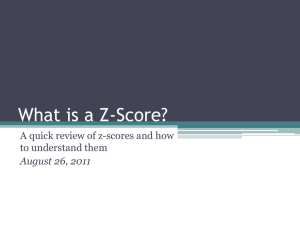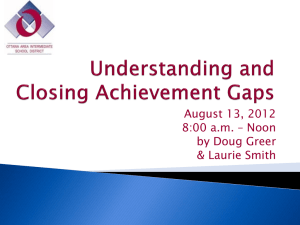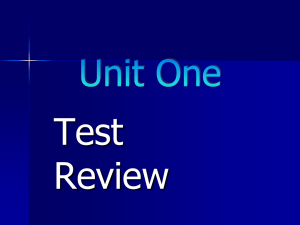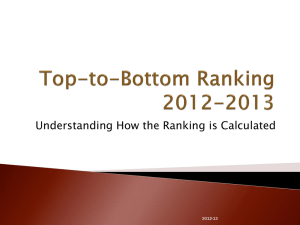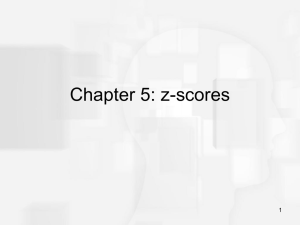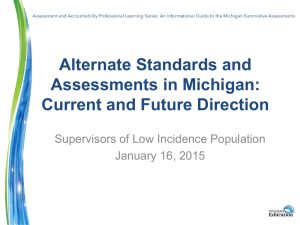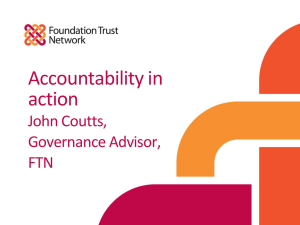Keesler Presentation
advertisement
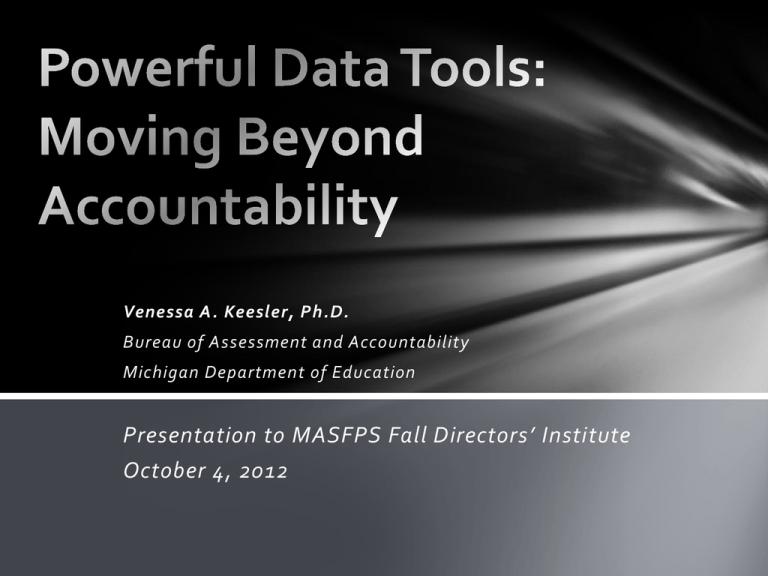
Venessa A. Keesler, Ph.D. Bureau of Assessment and Accountability Michigan Department of Education Presentation to MASFPS Fall Directors’ Institute October 4, 2012 Things I’ve learned about accountability since taking this job #1: NO ONE (and I do mean no one) likes accountability. #2: If you are the one who is holding people accountable, you are not going to be the most popular person in the room #3: See point number 1 So why do we do accountability? Three myths; one reality • Myth #1: To drive reform • Myth #2: To create education policy • Myth #3: Because we are gluttons for punishment Reality: • Accountability metrics/systems are quantitative articulations of the core policy beliefs of the education system • They help us measure our progress in meeting those core policy goals • They are the measure, not the purpose or the goal Accountability Landscape: 2012 A new era of accountability • Switching from a purely criterion-based system to a normative system • Criterion-based systems: Set average proficiency targets for schools. • Normative system: identifies the “worst” or “best” or “lowest” or “highest” Why the change? Policy imperative for NCLB: all students CAN and SHOULD demonstrate proficiency criterionsystem with proficiency targets for all schools and subgroups 10 years later: our average achievement is increasing, but we still have students and schools lagging behind New policy imperative (ESEA Flex): we must target our lowest performing schools AND our lowest performing students more specifically and strategically The problem with average proficiency rates at a school or district level “Never trust an average” Averages mask low performance Example: • Proficiency target is 50% • Sunshine School has 20 students, 10 of whom are proficient and 10 of whom are not. • Sunshine School meets it’s target; hooray! • BUT those 10 not proficient students are possibly left behind Michigan’s Accountability System Top to Bottom Ranking • Priority Schools (bottom 5%) • Focus Schools (largest achievement gaps) • Reward Schools (high performing, high progress, beating the odds) Accountability Scorecard • Proficiency targets for all schools Moving Beyond the Label We believe: • Accountability only measures the core policy beliefs • The data in the accountability metrics is useful and necessary for schools and districts to understand their performance • Understanding where you are as a school/district is the first step toward moving forward • Working smarter, not just harder Using the Top to Bottom Ranking Three main components by subject: • Achievement • Improvement in achievement over time • The largest achievement gap between two subgroups calculated based on the top scoring 30% of students versus the bottom scoring 30% of students Each component tells schools something about their overall performance and can be used for diagnostics Who receives a ranking? Schools with 30+ full academic year (FAY) students over the last two years in at least two state-tested content areas; school must be OPEN at time of list generation Application Some schools do not receive a ranking if they: Have too few FAY students Only have one year of data Tested Grades and Subjects Reading and Mathematics: Grades 3-8 and 11 • In grades 3-8, testing every year allows us to figure out student performance level change (our current “growth” metric) in reading and math • Students can either significantly improve, improve, maintain, decline or significantly decline Writing: Grades 4 & 7 Science: Grades 5 & 8 Social Studies: Grades 6 & 9 What about Reconfigured schools? A school must change by four or more grades in order to get a new code • Example: A K-2 building becoming a K-6 building. • New codes NOT granted when a school is reopened as a charter, for example If not, the school retains the old code and continues to have data “point” at it from all students for whom that code is their feeder school There is no “phase reset” like there was in AYP • If school population changed by 51%, could request a phase reset—still got AYP calculations, but sanctions delayed • Under Priority/Focus interventions, would simply have a customized intervention. Quick Reference for Z-Scores Why do We Use Z Scores? Z-scores are a standardized measure that helps you compare individual student (or school) data to the state average data (average scores across populations). Z-scores allow us to “level the playing field” across grade levels and subjects Each Z-score corresponds to a value in a normal distribution. A ZScore will describe how much a value deviates from the mean. What do you need to know: Z-scores are used throughout the ranking to compare a school’s value on a certain component to the average value across all schools. What is a Z-Score? Z-scores are centered around zero Positive numbers mean the student or school is above the state average Negative numbers mean the student or school is below the state average …Worse than state average -3 -2 -1 State Average 0 Better than state average…. 1 2 3 Z-Score Examples Your school has a z-score of 1.5. You are better than the state average. Z-score of 1.5 …Worse than state average -3 -2 -1 State Average 0 Better than state average…. 1 2 3 Z-Score Examples Your school has a z-score of .2. You are better than the state average, but not by a lot. Z-score of 0.2 …Worse than state average -3 -2 -1 State Average 0 Z-score of 1.5 Better than state average…. 1 2 3 Z-Score Examples Your school has a z-score of -2.0. You are very far below state average. Z-score of -2.0 Z-score of 0.2 …Worse than state average -3 -2 -1 State Average 0 Z-score of 1.5 Better than state average…. 1 2 3 How Is the Top to Bottom Ranking Calculated Two-Year Average Standardized Student Scale (Z) Score School Achievement Z-Score Improvement Metric (Performance Level Change OR Four Year Improvement Slope) School Improvement Z-Score 1/4 Two-Year Average Bottom 30% - Top 30% Z-Score Gap School Achievement Gap Z-Score 1/4 1/2 School Content Area Index Content Index Zscore How Is the Top to Bottom Ranking IMPORTANT PART RIGHT Calculated HERE!!! Two-Year Average Standardized Student Scale (Z) Score School Achievement Z-Score Improvement Metric (Performance Level Change OR Four Year Improvement Slope) School Improvement Z-Score 1/4 Two-Year Average Bottom 30% - Top 30% Z-Score Gap School Achievement Gap Z-Score 1/4 1/2 School Content Area Index Content Index Zscore How do we get Standardized Scale Scores for Each Student? Step #1: Take each student’s score on the test they took and compare that score to the statewide average for students who took that same test in the same grade and year This creates a student-level z-score for each student in each content area • Compare • • • • MEAP to MEAP MEAP-Access to MEAP-Access MME to MME MI-Access • Participation to Participation • Supported Independence to Supported Independence • Functional Independence to Functional Independence What do we do with those standardized scores? Step #2: Once each student has a z-score for each content area (based on the test they took), we take all of the students in a each school, and rank order the students within the school. • Z-scores will have come from different tests, and compare students to statewide average for that grade, test, and subject • But they can now be combined for the school Step #3: Add up all z-scores and take the average. This is now the average standardized student scale score. Step #4: Define the top and bottom 30% subgroups, based on that rank ordering. Student Test Taken Z-score Tommy Mi-Access, Participation 2.5 Sally MEAP 2.0 Maura MI-Access, SI 1.9 Fred MEAP 1.5 Ichabod MEAP-Access 1.0 Freud MEAP 0.8 Maybelle MI-Access, FI 0.7 Destiny MEAP 0.5 Harold MEAP -0.2 Bickford MI-Access, FI -0.5 Talledaga MEAP-Access -0.7 Francine MEAP -1.2 Joey MEAP -1.9 William MEAP -2.2 Student Test Taken Z-score Tommy Mi-Access, Participation 2.5 Sally MEAP 2.0 Maura MI-Access, SI 1.9 Fred MEAP 1.5 Ichabod MEAP-Access 1.0 Destiny Average Z-score (average MEAP standardized student scale MI-Access, FI score): 0.28 MEAP divide by 15) (sum all z-scores, Harold MEAP -0.2 Bickford MI-Access, FI -0.5 Talledaga MEAP-Access -0.7 Francine MEAP -1.2 Joey MEAP -1.9 William MEAP -2.2 Freud Maybelle 0.8 0.7 0.5 Student Test Taken Z-score Tommy Mi-Access, Participation 2.5 Sally MEAP 2.0 Maura MI-Access, SI 1.9 Fred MEAP Ichabod MEAP-Access 1.0 Freud MEAP 0.8 Maybelle MI-Access, FI 0.7 Destiny MEAP 0.5 Harold MEAP -0.2 Bickford -0.5 Talledaga MI-Access, FI Bottom 30% MEAP-Access Francine MEAP -1.2 Joey MEAP -1.9 William MEAP -2.2 Top 30% 1.5 -0.7 What is important to show Schools? Two-Year Average Standardized Student Scale (Z) Score School Achievement Z-Score Two-Year Average Performance Level Change Index School Performance Level Change Z-Score 1/2 1/4 School Content Area Index Step #1: Achievement How well did the school do in that subject? Two-Year Average Positive number = better than average Bottom 30% - Top School Achievement 30% Near = average1/4 Gapzero Z-Score Z-Score Gap Negative number = worse than average Content Index Zscore Step #2: Improvement Is the school improving in that subject? What is important to show Schools? Positive number = greater rate of improvement thanmathematics average For grade 3-8 reading and Near zero = average improvement Negative = slower rate of improvement than Two-Year Average School Achievement Standardized Student 1/2 are declining average; canZ-Score also mean they Scale (Z) Score Improvement Score School Improvement Z-Score 1/4 Two-Year Average Bottom 30% - Top 30% Z-Score Gap School Achievement Gap Z-Score 1/4 School Content Area Index Content Index Zscore Step #3: Achievement Gap gap in that subject between top 30% What isIs the important to show Schools? and bottom 30%: For grade (positive 3-8 reading and mathematics number) = smaller gap than average Two-Year Average (negative number) = larger gap than School Achievement Standardized Student 1/2 Z-Score average Scale (Z) Score (near zero) = average gap Improvement Value School Performance Level Change Z-Score 1/4 Two-Year Average Bottom 30% - Top 30% Z-Score Gap School Achievement Gap Z-Score 1/4 School Content Area Index Content Index Zscore Once they have looked at each component, Discuss: What’s the overall pattern? • Low achievement? • Declining achievement? • Large gaps? Where are the actionable areas? • Which subjects need the most attention? • Is everyone doing poorly (small gap, low achievement) or are some students doing well and others falling behind (decent achievement, but large gap) What is important to show Schools? For grade 3-8 reading and mathematics Two-Year Average Standardized Student Scale (Z) Score School Achievement Z-Score Two-Year Average Performance Level Change Index School Performance Level Change Z-Score 1/2 1/4 Reward Schools (for improvement) School Content Area Index Content Index Zscore Focus Schools Two-Year Average Bottom 30% - Top 30% Z-Score Gap School Achievement Gap Z-Score 1/4 An example from data: My daughter’s elementary school K-4 building Go here to get this tool: • www.mi.gov/ttb Final Point Accountability data does not tell ALL “Correlation does not imply causation, but it does waggle its eyebrows suggestively and gesture furtively while mouthing ‘look over there’.” Moving beyond the label only takes capacity at every level of the field Resources www.mi.gov/ttb • Individual school lookup tool • Diagnostic Worksheet www.mi.gov/priorityschools www.mi.gov/focusschools www.mi.gov/rewardschools Contact Information Venessa A. Keesler keeslerv@michigan.gov (personal email) mde-accountability@michigan.gov 877-560-8378, option 6
